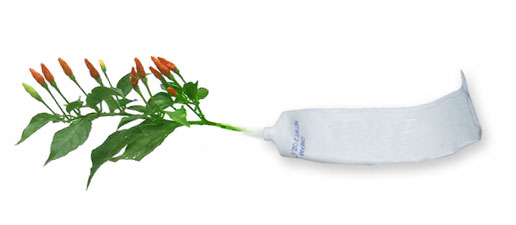|
General Info
When Carolus Linneus first identified the genus Capsicum in the
mid-1700s, there were only two species. By the 1900s, more than
100 cultivated species of Capsicums have been described. However,
the variations were so minor that horticulturists have distilled
the list anew to two: c. annuum, which includes cayenne peppers
and chiles, as well as bell peppers, and C. fructescens, which
is the pepper from which Tabasco sauce is made.
Capsaicin is the active ingredient
in the extract of hot peppers. It is most concentrated in the
rib or membrane, less in the seeds, least in the flesh. Capsaicin
for medicinal use comes from Capsicum fructescens, a species
of the cayenne pepper.
Mechanism of Action
Capsaicin depletes substance P in afferent type C sensory nerve
fibers and affects only proprioception. Unlike other treatments
for neuropathy, such as local anesthetics, opiates, anti-seizure
medications or tricyclic antidepressants, capsaicin specifically
treats pain without impairing other aspects of the nervous system.
In incomplete depletion of substance P from suboptimal use, it
may cause parodoxical increase of pain.
Uses
Post-herpetic neuralgia, post-mastectomy pain, hemodialysis-associated
pruritus, psoriatic itching and pain, painful neuropathies, especially
diabetic neuropathy, and other superficial neuropathies.
In a double-blind placebo-controlled
trial, topically applied capsicum cream provided significant
relief from soft tissue pain. 281 patients with musculoskeletal
pains of the back, shoulder, and neck were randomized to a placebo
cream or a cream with 2.5 g/100 g capsicum extract, both applied
three times daily for 21 days. There wre 74% (103) responders
in the active group vs 48% (63) in the placebo group, a difference
that is statistically significant. The treatment was well tolerated
with only 19 adverse events - 13 in the capsicum group (2, excessive
heat; one, pruritus) and 6 in the placebo group. The effect was
attributed to the depletion of the neurotransmitter involved
in transmission of pain signals to the brain.
Doses
Creams of varying potency from
0.01% and 0.075% applied 4-5 times daily for at least four weeks.
Because of local side effects, it is advisable to start with
low potency creams and increasing in potency as tolerated. Less
frequent application, such as once or twice daily, can actually
lead to increased pain. Older patients, especially those with
long-standing post-herpetic neuralgia, may require several years
of therapy and may even need lifelong treatment.Capsaicin is
also available as fresh and dried peppers, capsules, tablets,
and tinctures.
Precautions
Because of potential respiratory toxicity, avoid concentrations
greater than 0.1%. Higher concentrations are also more likely
to cause local chemical irritation. Wear gloves during applications,
avoiding contact with eyes and mucous membranes; do not use on
open abrasions and open wounds.
Formulation
Approved for external application, capsaicin is also available
as tablets, capsules and tinctures.
Capsaicin and
Dyspepsia
In a small trial in Italy (Dr. Mauro Bortolotti et al, University
of Bologna), 30 patients with functional dyspepsia were randomized
on daily capsules of 2.5 g of red pepper or placebo. The capsaicin
content (trans-8-methyl-N-vanillyl-6-nonenamide) was 0.7 mg/g
of red pepper power. After 3 weeks, upper gastrointestinal symptoms
of epigastric pain, fullness, nausea and early satiety were all
significantly reduced in the capsaicin group and not in the placebo
group. The mechanism of action is believed to be the desensitization
of gastric nociceptive C fibers, which carry pain sensations
to the central nervous system. (NEJM.346[12]:947-48,2002) Clinical Capsules. Internal
Medicine News. May15,2002
|



